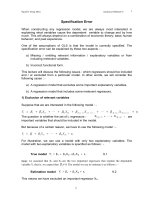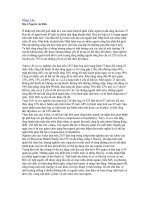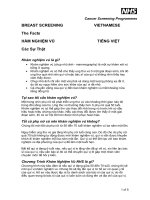Tài liệu Breast Cancer docx
Bạn đang xem bản rút gọn của tài liệu. Xem và tải ngay bản đầy đủ của tài liệu tại đây (633.73 KB, 11 trang )
Krystal Bottom, MD
Maura O’Leary, MD
Jan Sheaffer, BA
Marianne Phillips, MBCHB, MD
Xiao-Ou Shu, PhD
Banu Arun, MD
Chapter 9
Breast Cancer
Cancer in 15- to 29-Year-Olds in the United States
CHAPTER 9 BREAST CANCER
SEER AYA Monograph 112 National Cancer Institute
HIGHLIGHTS
Incidence
• Breast cancer in adolescents and young adults is rare. From 1975 to 2000, less than 0.1% of all breast cancer occurred
in young women under 30 years of age.
• There was an increase in the average incidence of breast cancer per million females per year across the adolescent
and young adult age groups during the period 1975 to 2000: incidence was 1.3 in 15- to 19-year-olds, 12.1 in 20- to
24-year-olds, rising to 81.1 in 25- to 29-year-olds.
• Breast cancer incidence for African American/black adolescents and young adults was more than twice that of white
non-Hispanic women of similar age. This incidence trend reversed between the ages of 45 and 50 years; African
American/black women 45 years and older had a lower incidence than white women.
• American Indian/Alsaka Native women had the lowest incidence of breast cancer, regardless of age.
Mortality & Survival
• Death rates for breast cancer rose steadily with increasing age.
• Mortality was much higher for African Americans/blacks and to a lesser extent those of Hispanic ethnicity at all
ages than for white, non-Hispanic young women.
• Survival rates have improved over time. White non-Hispanic patients experienced greater improvements in survival
rates than Hispanic and African American/black patients.
• Survival is lower for women 15 to 29 years of age than for older women, regardless of histologic subtype and stage.
• Socioeconomic factors, including access to care and health insurance coverage, affect mortality.
Risk Factors
• The primary risk factor for the development of breast cancer in women of all ages is a family history of breast
cancer.
• Risk factors in adolescence and young adulthood include germline mutations of BRCA1, BRCA2, p53 (Li Fraumeni
syndrome), Muir’s Syndrome and PTEN (Cowden’s syndrome).
• Prior mantle radiation for Hodgkin disease is a risk factor for the development of breast cancer in young women.
• Age younger than 35 years at diagnosis is a risk factor for the development of aggressive disease.
• African American/black race, particularly for those younger than 45 years of age, and increased parity in young
African/black women are risk factors.
• Increased breast tissue density in women over the age of 35 is considered a risk factor.
INTRODUCTION
Breast cancer is rare in adolescent girls and young
women, and even more rare in males of this age group.
Due to lack of data about male breast cancer, this
chapter will present data pertaining to female patients
only. When breast cancer occurs in adolescents and
young women, it tends to be more aggressive and has a
worse prognosis than when it occurs in older women.
1-
3
Adolescents and young women tend to have more
advanced disease, in part due to the poor correlation
of standard mammography fi ndings with extent of
disease.
1,4
Age is an independent prognostic factor even
when size and nodal status are considered—younger
aged patients have a worse prognosis.
1,2
These patients
have a higher incidence of invasive ductal carcinoma
with an aggressive biological behavior and are more
likely to have lymphovascular invasion.
3
Young women
are more likely to have tumors that are estrogen-
receptor negative.
1,4,5
National Cancer Institute 113 SEER AYA Monograph
CHAPTER 9 BREAST CANCER
METHODS, CLASSIFICATION SYSTEM, AND
BIOLOGICAL IMPLICATIONS
The International Classifi cation of Childhood Cancer (ICCC)
has no specifi c category for breast cancer. These cancers
are contained with category XI(f),
Other and Unspecifi ed
Carcinomas,
as one of the
Carcinomas and Other Epithelial
Neoplasms
(category XI). Hence, the SEER site recode
based on the International Classifi cation of Diseases for
Oncology (ICD-O) was used exclusively for this chapter.
For breast cancer, the ICD-O Topography codes are C50.0-
C50.9 (all tissues in the breast except overlying skin) and
the ICD-O categories include general carcinomas and
adenocarcinomas (8010-8041, 8140, many others) and
specifi c carcinomas of the breast. The latter are found in
the ICD-O group
Ductal and Lobular Neoplasms
(8500-
8543) and include intraductal, lobular, infl ammatory,
comedo-, intracystic, and Paget’s types, and various
combinations of these histologies.
As explained in the
Methods
chapter, data are presented
for 15- to 29-year-olds with comparisons to the age
groups 0 to 15 years and 30 to 44+ years, as appropriate.
For some analyses the entire age range from birth to 85+
years is included. The absence of data in any fi gure or
table within this chapter means that too few cases were
available for analysis; it does not mean that the rate or
change in rate was zero.
Since the ICCC was set up as a classification for
childhood cancer, it does not have a separate category
for breast cancer. Topography and histology from ICD-O
can be used to examine differences among very young
breast cancer patients compared to older patients, but it
is unclear whether this is suffi cient to explain all of the
biologic differences, given that the younger breast cancer
patients in general experience poorer survival than older
breast cancer patients.
INCIDENCE
The SEER incidence data in this section were collected
between 1975 and 2000. Less than 1% of all breast cancer
cases occurred in women under the age of 30. Breast can-
cer incidence rose steadily with age, stabilized, and then
dropped slightly after 80 years of age (Figures 9.1, 9.2).
Figure 9.1:
Incidence of Breast Cancer Relative to All Cancer in
Females, U.S., SEER 1975-2000
Figure 9.2:
Incidence of Breast Cancer in Females, SEER 1975-
2000
Figure 9.3:
Incidence of Breast Cancer in Females by Extent of
Disease at Diagnosis, SEER 1975-2000
CHAPTER 9 BREAST CANCER
SEER AYA Monograph 114 National Cancer Institute
Over the period 1975 to 2000, there was an increase in
incidence of breast cancer with increasing age, from an
average incidence per million of 1.3 in 15- to 19-year-olds,
to 12.1 in 20- to 24-year-olds, to 81.1 in 25- to 29-year-olds
(Table 9.1). However, there was no annual increase within
each age group apparent over the same time period.
As shown in Figure 9.3, the incidence of regional spread
of disease was higher for adolescents and young adults
than for women older than 30 years of age.
Racial/Ethnic Differences in Incidence
From 1992 to 2002, African American/black women
from 10 to 34 years of age had a higher rate of breast can-
cer than any other race/ethnicity (Figure 9.4). Above age
50, however, breast cancer predominated in non-Hispanic
white women (data not shown). At all ages, American
Indian/Alaska Native women had the lowest incidence
of breast cancer (Figure 9.4; data not shown for older
females).
Trends in Incidence
The incidence of breast cancer in young women has
remained relatively stable over the period 1975 to
2000 (Figures 9.5).
OUTCOME
Mortality
During the period 1975 to 2000, breast cancer mortal ity
rose steadily with age (Figure 9.6), refl ecting an increasing
breast cancer incidence (Figure 9.2). The mortality:inci-
dence ratio was lower in the 15- to 29-year age range
than in the 30- to 44-year range (Figure 9.7), implying
that survival was better among the younger patients. This
apparent advantage for the younger age group may be due
either to a higher cure rate or to a longer interval to death,
such that the deaths from breast cancer among those diag-
nosed between 15 and 29 years of age occur primarily
after age 30. Survival data shown below indicate that it
was not due to a higher survival rate.
Table 9.1:
Incidence of Breast Cancer in Persons Younger Than 30 Years of Age, U.S., 1975-2000
AGE AT DI AGNOSIS (Y E ARS)
<5 5-9 10-14 15-19 20-24 25-29
U.S. population, year 2000 census (in millions), females
9.365
10.026
10.008
9.829
9.276
9.583
Average incidence per million, 1975-2000, SEER
^
^
^
1.3
12.1
81.1
Average annual % change in incidence, 1975-2000, SEER
^
^
^
0
0
0
Estimated incidence per million, year 2000, U.S.
^
^
^
1.3
12.1
81.1
Estimated number persons diagnosed, year 2000, U.S.
^
^
^
13
112
777
^ Too few for a reliable estimate
Figure 9.4:
Incidence of Breast Cancer in Females by Race/
Ethnicity, SEER 1992-2001
Figure 9.5:
Change in Incidence of Breast Cancer in Females
by Era, SEER
National Cancer Institute 115 SEER AYA Monograph
CHAPTER 9 BREAST CANCER
Mortality for all age groups remained stable or dropped
since 1981. The decrease in mortality was more pro-
nounced for those over 30 years of age, particularly in the
most recent treatment era (Figure 9.8), and likely refl ects
the use of screening programs, improved diagnostic tech-
niques, and adjuvant chemotherapy and radiation therapy.
There was a more signifi cant improvement in mortality
over time for older age groups.
Racial/Ethnic Differences in Mortality
For women younger than 45 years of age, mortality for
African Americans/blacks was nearly twice as high as
for other racial/ethnic groups (Figure 9.9). Although
African Americans/blacks had an increased incidence of
breast cancer compared to other groups, the death rate
for this group was disproportionately higher than the in-
cidence difference (Figure 9.4). African American/black
patients have been reported to present with higher stage
or more advanced disease.
6,7
White non-Hispanic wo-
men were signifi cantly more likely to be older and to
have small er tumors, have less lymph node involvement,
have tumors with positive estrogen receptor and proges-
terone receptor status compared with Hispanic or African
American/black women.
6
An additional analysis of treatment modalities used for
women under 35 years of age with invasive breast cancer
revealed that African American/black women—and to
some extent Hispanic females—received less aggressive
initial therapy than white non-Hispanic women, des-
pite similar prognostic variables. These analyses were
multivariate and were adjusted for stage, grade, lymph
node status, and treatment. Overall, 9% of the women
in this study were registered on clinical trials, yet Afri-
can American/black women were less likely than others
to be among those registered. African American/black
and Hispanic women had poorer outcomes and a higher
mortality than white, non-Hispanic women.
6
Figure 9.10 displays mortality data for white and African
American/black women over the period 1975 to 2000.
For white Americans there was a relatively consistent
decline in the death rate across all age groups, but for
African Americans/blacks, either an increase in death
rate or stable death rate was observed.
Figure 9.6:
National Mortality for Breast Cancer in Females,
U.S., 1975-2000
Figure 9.7:
Ratio of National Mortality to SEER Incidence for
Breast Cancer in Females, U.S., 1975-2000
Figure 9.8:
National Mortality for Breast Cancer in Females,
U.S., by Era
CHAPTER 9 BREAST CANCER
SEER AYA Monograph 116 National Cancer Institute
Data analysis of death from breast cancer (1973 to
2000) and its association to age at diagnosis, stage, and
ethnicity indicates that breast cancer was the cause of
death more often in younger patients as compared to
older patients, and was associated with advanced stage
and race. African American/black women did not achieve
survival rates similar to white non-Hispanic women.
8
Trends in Mortality
A reduction in breast cancer mortality occurred over time,
and was signifi cant for each age group. This improvement
has been considerable in more recent years (Figure 9.11).
The average annual percent change in mortality for
whites compared to African Americans/blacks reveals
a signifi cant discrepancy between the two racial groups.
Whites experienced substantial improvements in survival
in all age groups in the period 1975 to 2000—improve-
ments not observed in the African American/black pop-
ulation. Decreases in mortality during this period were
three times greater for whites than for African Ameri-
cans/blacks (Figure 9.12).
Survival
Five-year survival rates for breast cancer, by age, revealed
that survival was lowest for those in the adolescent and
young adult age group. Within that group, 25- to 29-year-
old women had slightly lower survival rates than those
younger or older (Figure 9.13). This lower survival rate for
15- to 29-year-old women may be due to several factors:
breast cancer in young women is typically invasive,
more aggressive and associated with a worse prognosis
Figure 9.9:
National Mortality for Breast Cancer in Females by
Race/Ethnicity, 1990-2000
Figure 9.10:
National Mortality for Breast Cancer in Females
by Era, 1975-2000
Figure 9.11:
Average Annual Percent Change (AAPC) in National
Mortality for Breast Cancer in Females, 1975-2000
Figure 9.12:
Average Annual Percent Change (AAPC) in National
Mortality for Breast Cancer in Females, by Race, 1975-2000
National Cancer Institute 117 SEER AYA Monograph
CHAPTER 9 BREAST CANCER
than in older women,
1,2
detection rates are lower due to
lack of suspicion in the general population and medical
community, and breast tissue in younger women is
commonly more dense than in older women, resulting in
mammography results which may be inconclusive.
Five-year survival rates, by era, revealed that although
survi val rates for the adolescent and young adult pop-
ulation remained relatively stable over time, slight improve-
ment was seen in the most recent era (Figure 9.14).
Breast cancer survival is consistently lower for adolescent
and young adult women than for other age groups, regar-
dless of histologic type. For all age groups, 5-year survival
is limited for women with infl ammatory disease (Figure
9.15). Lower survival rates refl ect the aggressive biologic
and pathologic characteristics of tumors specifi c to this age
group, and the fact that routine screening for breast cancer
is not the standard of care in adolescents and young adults.
Although treatment modalities have improved considerably
over the last 30 years, due to National Cancer Institute
initiatives for the care of breast cancer patients, improve-
ments in survival have not been observed in adolescents
and young adults to the extent seen in older females.
Five-year survival rates were generally low for 20- to
24-year-old women, except for those with localized dis-
ease at diag nosis. For localized disease, women in the
age groups 20 to 24 and 40 to 44 had high survival rates,
although rates were relatively high for all ages (Figure
9.16). For region al and distant disease, survival rates in-
creased with age. As expected, survival for all women
was best for those with localized disease, followed by
those with regional disease. Survival was poor for all
women with distant disease (Figure 9.16).
The average annual percent change in 5-year survival
rates from 1975 to 2000 is shown in Figure 9.17. For young
women 15 to 29 years of age, decreases in 5-year survival
rates were noted for localized and regional disease. De-
creases were also seen for women 30 to 44 years of age
with regional disease, but signifi cantly better survival was
noted for those with localized or distant disease. For those
over 45 years of age, improvement—which was signifi -
cant—was observed only for those with localized disease.
This may indicate the benefi t of awareness campaigns and
breast cancer screening in the older population.
Figure 9.13:
5-Year Survival Rate for Breast Cancer in Females,
SEER 1975-1999
Figure 9.14:
5-Year Survival Rate for Breast Cancer in 15- to
29-Year-Old Females, by Era, SEER 1975-1999
Figure 9.15:
5-Year Survival Rate for Breast Cancer in Females
by Histologic Type and Age, SEER 1975-1999
CHAPTER 9 BREAST CANCER
SEER AYA Monograph 118 National Cancer Institute
Figure 9.17:
Average Annual Percent Change (AAPC) in 5-Year
Survival Rates for Breast Cancer in Females by Age and Extent
of Disease, SEER 1975-2000
RISK FACTORS
Due to the low incidence of breast cancer in adolescents
and young adults, relatively few epidemiological studies
have been undertaken with the focus on this age group.
Much of the information listed below is based on studies
of women under 35 or 40 years of age; in a few studies
age was stratifi ed at above and below 50 years.
General risk factors for the development of breast can-
cer include age, reproductive history, personal or family
history of breast cancer, and environmental exposure to
carcinogens.
9
A signifi cant risk factor for breast cancer
is family history—specifi cally in a fi rst- or second-de-
gree relative. However, even with increased risk, only 5
percent of familial breast cancers studied are consistent
with hereditary breast cancer.
10-12
Young women with germline mutations in BRCA1,
BRCA2, p53 (Li Fraumeni syndrome), Muir syndrome,
or PTEN (Cowden’s syndrome) are at increased risk for
breast cancer.
9,13
Women who carry a BRCA1 or BRCA2
mutation have a lifetime risk of breast cancer as high as
80-90%, although lower risk estimates of 37-56% have
also been reported.
14
Young female patients are more likely to carry p53
mutations, and perturbations of the p53 pathway are
associat ed with more aggressive and therapeutically
refractory tumors.
15
Li Fraumeni syndrome is a rare,
dominantly inherited condition caused by a germline
mutation in the Tp53 gene on chromosome 17.
16
Affected
Figure 9.16:
5-Year Survival Rate for Breast Cancer in Females by Age and Extent of Disease at Diagnosis, SEER 1975-1999
National Cancer Institute 119 SEER AYA Monograph
CHAPTER 9 BREAST CANCER
patients have a 50% risk of developing cancer by age 35
and a 90% risk of developing cancer in their lifetime.
Muir syndrome is a familial cancer family variant
with basal cell carcinomas and benign and malignant
colon tumors.
17
Cowden’s syndrome is caused by a rare
mutation in PTEN gene on chromosome 10.
18
Affected
patients have an increased risk of developing breast
or thyroid carcinoma at a young age and often have
multiple hamartomas.
Race/ethnicity is a risk factor for the development of
breast cancer. Incidence is higher in African Ameri-
cans/black women younger than 50 years of age than
for other racial/ethnic groups, even in the adolescent
and young adult subset.
19
African American/black
women more often present with distant disease than
white women, and mortality in this group exceeds that
of the white population. Yet for women born after 1950,
mortality has decreased, and the African American/
black population has experienced more benefi t than the
white population.
20
Reasons for these racial/ethnic disparities include age,
tumor histology, premenopausal endogenous hormones
and growth factors levels, and parity. African Ameri-
can/black women younger than 45 years of age were
more likely to develop breast cancer than those over 45,
whereas white women over the age of 45 were more likely
to develop breast cancer than those under 45.
7
African
American/black women under the age of 50 were also
noted to have more aggressive tumor histology.
19
In a
population-based study of women with breast cancer, a
signifi cant difference in the expression of p53, late stage
tumors, larger tumors, positive lymph nodes, and higher
histologic grade was seen in African American/black
women as compared to white women.
21
Racial differen-
ces in levels of endogenous hormones and growth factors
indicate that African American/black women under 45
years of age are at higher risk of developing breast cancer
than their white counterparts.
22
African American/black
women were more likely to have had an early fi rst birth
(when younger than 20 years of age) and higher parity
than white women, with a higher risk of breast cancer at
younger ages.
23,24
African American/black women were
more likely to have estrogen-receptor negative tumors
than white women, which is a risk factor in itself.
25
In
regards to treatment for breast cancer, African Ameri-
can/black women are more likely than white women to
undergo breast-conserving surgery or have no surgery
for their disease.
26
They are also less likely to receive
post-operative radiation therapy than white women.
6
Treatment is affected by socioeconomic factors such
as access to care, lack of health insurance, and type of
health insurance coverage.
26
Age is an independent risk factor; women under 35 years
more often have a palpable mass at diagnosis, undifferen-
tiated tumors, grade 3 tumors, negative hormone receptor
status, and microscopic lymph node involvement.
1,2
An
increase in the incidence of infi ltrating ductal carcinoma in
women younger than 39 years of age was noted in a British
study, with a decrease in regional and distant disease with
advancing age.
3
A French study found that women younger
than 40 years of age had tumor histology associated with
high nuclear grade and vascular invasion.
27
Other risk factors include circulating enzyme and hor-
mone levels and breast tissue density. A recent study in-
dicated that increased cytochrome P450 1A2 function
may be associated with an increased risk of developing
breast cancer.
28
The risk of developing estrogen-negative
breast cancer may be higher in women with particular
enzyme genotypes.
29
In women over 35 years of age and
particularly over age 50, increased density of breast tis-
sue—independent of ethnicity—is a risk factor for the
development of breast cancer.
30
A unique group at risk for the development of breast
cancer consists of adolescent and young adult survivors
of Hodgkin lymphoma. The risk of developing breast
cancer appears to be related to the quantity and loca-
tion (chest/mantle) of prior radiation therapy, with or
without alkylating agent-based chemotherapy; this risk
increases over time.
13,31,32
SUMMARY
Breast cancer is rare in adolescents and young women
but has a worse prognosis than for older women. Young
females with breast cancer are more likely to present
with region al spread prior to diagnosis.
5
Adolescents
and young women are not considered at risk for breast
CHAPTER 9 BREAST CANCER
SEER AYA Monograph 120 National Cancer Institute
cancer, therefore they may not seek early medical
atten tion or concerns may be dismissed by medical
practitioners. Breast cancer in this age group may
also be more diffi cult to detect due to dense breast
tissue. None theless, there is evidence that breast
cancer is more virulent in young females, with a worse
prognosis for the same stage of disease at diag nosis.
There is a higher incidence of germline mutations of
BRCA1, BRCA2, Tp53, and PTEN in this age group.
Survival data demonstrate striking racial differences.
African Americans/blacks—and to a lesser degree His-
panics—fare poorly compared to whites. Although pro-
gress has been made, there is much to accomplish for the
youngest women and women of color. Effective screen-
ing programs are needed to help identify early disease
in these at-risk groups. These young women should be
encouraged to participate in such programs at an early
age and throughout their lives.
REFERENCES
1. Bonnier P, Romain S, Charpin C et al.: Age as a prognostic factor in breast cancer: relationship to pathologic
and biologic features. Int J Cancer 1995;62:138-44.
2. Gajdos C, Tartter PI, Bleiweiss IJ, Bodian C, Brower ST: Stage 0 to stage III breast cancer in young women. J Am
Coll Surg 2000;190:523-9.
3. Fisher CJ, Egan MK, Smith P, Wicks K, Millis RR, Fentiman IS: Histopathology of breast cancer in relation to age.
Br J Ca 1997;75:593-6.
4. Gillett D, Kennedy C, Carmalt H: Breast cancer in young women Aust N Z J Surg 1997;67:761-4.
5. Chung M, Chang HR, Bland KI, Wanebo HJ: Younger women with breast carcinoma have a poorer prognosis
than older women Cancer 1996;77:97-103.
6. Shavers VL, Harlan LC, Stevens JL: Racial/ethnic variation in clinical presentation, treatment, and survival
among breast cancer patients under age 35. Cancer 2003;97:134-47.
7. Ries LAG, Kosary CL, Hankey BF, Miller BA, Edwards BK (eds): SEER Cancer Statistics Review, 1973-1995, National
Cancer Institute. Bethesda, MD, 1998.
8. Schairer C, Mink PJ Carroll L, Devesa SS: Probabilities of death from breast cancer and other causes among
female breast cancer patients. J Natl Cancer Inst 2004;96:1311–21.
9. Woods WC, Hyman B, Muss HB, Solin LJ, Olopade OI: Malignant tumors of the breast. In: DeVita VT Jr, Hellman
S, Rosenberg SA (eds): Cancer: Principles & Practice of Oncology, 7th edition. Philadelphia, Pennsylvania:
Lippincott Williams & Wilkins, 2005, p. 1415.
10. Ottman R, Pike MC, King MC, Henderson BE: Practical guide for estimating risk for familial breast cancer. Lancet
1983;2:556-8.
11. Anderson DE: Genetic study of breast cancer: identification of a high risk group. Cancer 1974;34:1090-7.
12. Lynch HT, Guirgis HA, Brodkey F, et al.: Genetic heterogeneity and familial carcinoma of the breast. Surg Gy-
necol Obstet 1976;142:693-9.
13. Shannon C, Smith IE: Breast cancer in adolescents and young women. Eur J Cancer 2003;39:2632-42.
14. Easton DF, Ford D, Bishop DT: Breast and ovarian cancer incidence in BRCA1-mutation carriers. Breast Cancer
Linkage Consortium. Am J Hum Genet 1995;56:265-71.
15. Lai H, Lin L, Nadji M, Lai S, Trapido E, Meng L: Mutations in the p53 tumor suppressor gene and early onset
breast cancer. Cancer Biol Ther 2002;1:31-6.
16. Li FP, Fraumeni JF Jr.: Soft-tissue sarcomas, breast cancer, and other neoplasms. A familial syndrome? Ann
Intern Med 1969;71:747-52.
17. Srivastava A, McKinnon W, Wood ME: Risk of breast and ovarian cancer in women with strong family histories.
Oncology (Williston Park) 2001;15:889-902; discussion 902, 905-7, 911-13.
18. Nelen MR, Padberg GW, Peeters EA, et al.: Localization of the gene for Cowden disease to chromosome 10q22-
23. Nat Genet 1996;13:114-6.
National Cancer Institute 121 SEER AYA Monograph
CHAPTER 9 BREAST CANCER
19. Middleton LP, Chen V, Perkins GH, Pinn V, Page D: Histopathology of breast cancer among African-American
women. Cancer 2003;97(1 Suppl):253-7.
20. Jatoi I, Anderson WF, Rao SR, Devesa SS.: Breast cancer trends among black and white women in the United
States. J Clin Onocl 2005;23:7836-41.
21. Jones BA, Kasl SV, Howe CL et al.: African American/White differences in breast carcinoma. p53 alterations
and other tumor characteristics. Cancer 2004;101:1293-301
22. Pinheiro SP, Holmes MD, Pollak MN, Barbieri RL, Hankinson SE: Racial differences in premenopausal endoge-
nous hormones. Cancer Epidemiol Biomarkers Prev 2005;14:2147-53
23. Palmer JR, Wise LA, Horton NJ, Adams-Campbell LL, Rosenberg L: Dual effect of parity on breast cancer risk
in African-American women J Natl Cancer Inst 2003;95:478-83.
24. Hall IJ, Moorman PG, Millikan RC, Newman B: Comparative analysis of breast cancer risk factors among African-
American women and white women. Am J Epidemiol 2005;161:40-51.
25. O’Malley CD, Le GM, Glaser SL, Shema SJ, West DW: Socioeconomic status and breast carcinoma survival in
four racial/ethnic groups. A population-based study. Cancer 2003;97:1303-11.
26. Bradley CJ, Given CW, Roberts C: Race, socioecomonic status, and breast cancer treatment and survival. J Natl
Cancer Inst 2002;94:490-6.
27. Bertheau P, Steinberg SM, Cowan K, Merino MJ: Breast cancer in young women: clinicopathologic correlation
Semin Diagn Pathol 1999;16:248-56.
28. Hong C-C, Tang B-K, Hammond GL, Tritchler D, Yaffe M, Boyd NF: Cytochrome P450 1A2 (CYP1A2) activity and
risk factors for breast cancer: a cross-sectional study. Breast Cancer Res 2004;6:R352-65.
29. Sparks R, Ulrich CM, Bigher J, et al.: UDP-glucuronosyltransferase and sulfotransferase polymorphisms, sex hor-
mone concentrations, and tumor receptor status in breast cancer patients. Breast Cancer Res 2004;6:R488-98.
30. Ursin G, Ma H, Wu AH, et al.: Mammographic density and breast cancer in three ethnic groups. Cancer Epide-
miol Biomarkers Prev 2003;12:332-8.
31. Bhatia S, Robison LL, Oberlin O, et al.: Breast cancer and other second neoplasms after childhood Hodgkin’s
disease. N Engl J Med 1996;334:745-51.
32. Travis LB, Hill D, Dores GM, et al.: Cumulative absolute breast cancer risk for young women treated for Hodgkin
Lymphoma. J Natl Cancer Inst 2005;97:1428-37.









